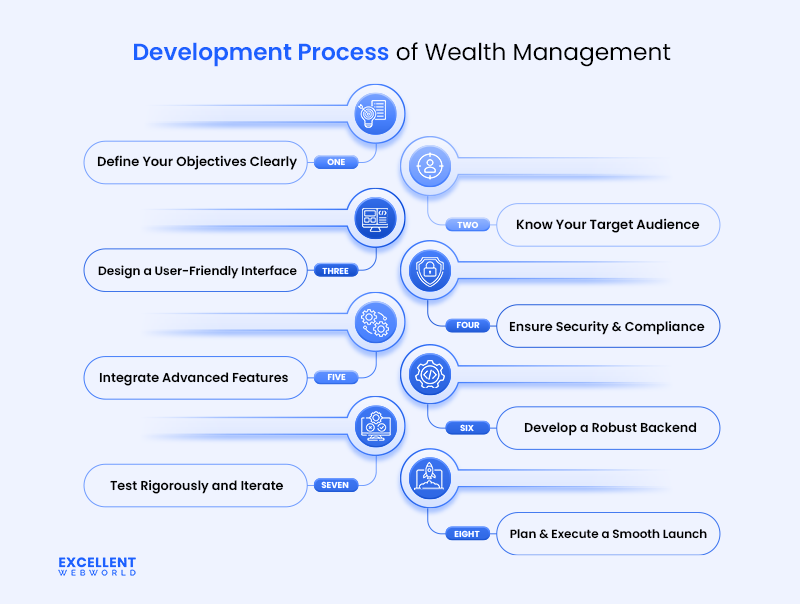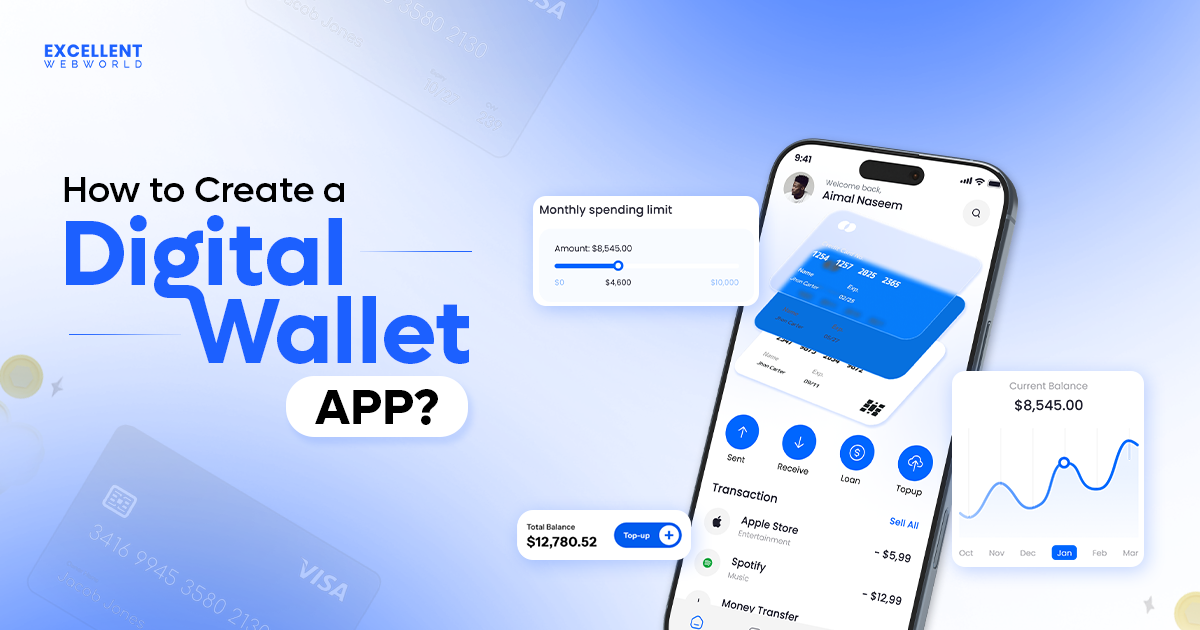Why do financial advisors, investment firms, private banks, or high-net-worth & ultra-high-net-worth individuals need wealth management software?
Because financial markets shift in minutes, risks multiply quickly, and clients demand instant insights, and to balance all of this at once, it’s highly recommended to have custom wealth management software in place.
Managing wealth is no longer just about smart advice; it’s about leveraging data, staying compliant, and building stronger relationships—all of which are possible to accomplish only with wealth management software. Through wealth management software development, firms gain the tools to safeguard client assets, improve decision-making, and deliver consistent growth.
Moreover, given the rapid shift that’s already happening, such as AI advisors, AI-driven analytics, and digital-first clients, wealth management software testing has become crucial to ensure that systems are not only innovative but also secure, compliant, and ROI-driven.
As a software development consultant we help firms build reliable, ROI-driven solutions that transform financial services. Taking from my experience as a CTO, I’ll break down the real benefits, key features, and market opportunities of wealth management software. I’ll guide you on how getting custom wealth management software developed and tested can help firms build reliable, ROI-driven solutions that transform financial services.
What Exactly Is Wealth Management Software and How Does It Work?
Wealth management software is a digital platform that helps financial advisors, banks, and investment firms manage client money in one place. It combines portfolio tracking, investment analysis, financial planning, risk checks, compliance, and client communication into a single system—making work faster and more accurate.
The wealth management software market is booming, valued at USD 4.86 billion in 2023 and expected to reach USD 15.55 billion by 2032 with a 13.8% CAGR. With such rapid growth, it’s becoming a key tool for delivering smarter, personalized financial advice.
What Types of Wealth Management Software Should You Know About?
Wealth management software is not one-size-fits-all. Different tools serve different purposes, depending on whether a firm needs all-in-one functionality or specialized solutions. From portfolio tracking to financial planning, each type of software plays a role in helping advisors manage money smarter. Let’s look at the main types.
1. All-in-One & Enterprise Platforms
These are comprehensive wealth management systems that combine everything, CRM, financial planning, portfolio management, reporting, and compliance; into one interface. They are perfect for large firms or RIAs who want scalability and streamlined operations.
2. Financial Planning Software
Advisors use these tools to model retirement, savings goals, tax strategies, and cash flow scenarios. They make it easier for clients to visualize their financial future. Fintech trends continue to shape how advisors deliver smarter, more personalized planning experiences.
3. Portfolio Management Software
Portfolio tools focus on investment oversight; tracking performance, asset allocation, and risk. This is essential for advisors who need clear insights into client holdings.
4. CRM (Customer Relationship Management) Software
Strong client relationships are key in wealth management. CRMs designed for finance help advisors track interactions, automate communication, and stay compliant. Some firms opt for custom crm software development to build a system tailored to their specific needs.
5. Reporting & Analytics Software
These tools go beyond spreadsheets. They turn raw data into clean, visual reports that clients actually understand. Advisors can highlight growth, compare strategies, and build trust with crystal-clear insights.
6. Trading & Rebalancing Platforms
Markets shift constantly, and portfolios drift from their targets. Rebalancing platforms step in to automate trades, cut down human error, and maintain tax efficiency—keeping strategies sharp and stress-free.
7. Risk Tolerance Assessment Tools
Not every client likes risk the same way. These tools use smart surveys and algorithms to measure comfort levels, helping advisors match investments to personalities—calm investors get safe bets, risk-takers get bolder plays.
What Are the Exact Steps for Developing Wealth Management Software from Scratch?
Building a successful wealth management system takes more than just coding, it needs clear planning, strong execution, and constant refinement. Here’s a guide to make your software development process for wealth management smooth and effective:
1. Define Your Objectives Clearly
Start by setting your goals. Do you want to improve portfolio tracking, client reporting, or compliance management? Clear objectives keep your wealth management systems aligned with business needs.
2. Know Your Target Audience
Understand who will use your platform, financial advisors, banks, or investment firms. Their needs shape your product features, just like how MVP development helps test ideas quickly before scaling.
3. Design a User-Friendly Interface
A simple, clean design improves adoption. Hire a UI/UX designer to create an intuitive interface that makes navigation easy, boosts trust, and ensures clients feel in control of their finances.
4. Ensure Security and Compliance
Financial data is sensitive. Your wealth management system must meet strict regulations like GDPR or SEC guidelines. Security features such as encryption, multi-factor authentication, and audit trails are non-negotiable. This is where a strong cybersecurity risk management plan and cybersecurity program development become critical.
5. Integrate Advanced Features
Modern wealth management systems need features like robo-advisory, AI-driven insights, automated reporting, and CRM. These not only add value but also differentiate your solution in a competitive market.
6. Develop a Robust Backend
Scalability and performance matter. A strong backend ensures your wealth management software development process supports large volumes of users, fast transactions, and smooth data handling.
7. Test Rigorously and Iterate
Testing is where your platform proves its reliability.
8. Plan and Execute a Smooth Launch
After successful testing, plan a phased rollout instead of a big bang release. Start with a soft launch for a limited user group, gather feedback, and refine. Then move toward a wider launch with training materials, onboarding support, and customer service in place to ensure smooth adoption.
How Much Does Wealth Management Software Development Cost?
The cost of wealth management software development can vary widely depending on the features, complexity, and type of wealth management system you want to build. A basic platform with essential tools will have a lower software development cost, while an enterprise-grade solution with advanced analytics, AI, and automation will be higher. Other factors like security, compliance, and wealth management software testing also affect the budget.
Here’s a quick overview of estimated costs based on software type:
| Type of Wealth Management Software | Key Features | Estimated Cost Range (USD) |
|---|---|---|
| Basic Portfolio Tracker | Portfolio tracking, simple reports | 10,000 – 30,000+ |
| Financial Planning Software | Retirement planning, goal tracking | 30,000 – 50,000+ |
| CRM & Client Management | Client profiles, automated communication | 40,000 – 70,000+ |
| All-in-One Platform | Portfolio, CRM, compliance, reporting | 50,000 – 90,000+ |
| Robo-Advisory / AI-Driven Systems | Automated investing, AI insights | 100,000+ |
Key Cost Drivers:
Investing in custom wealth management software development may seem higher initially, but it delivers better scalability, personalized client experience, and long-term ROI compared to off-the-shelf solutions. A key part of this process is software project estimation, which helps to accurately budget for the development.
What Are the Biggest Benefits of Using Wealth Management Software?
Wealth management software makes managing money smarter, faster, and safer. For advisors and firms juggling portfolios, regulations, and client expectations, the right wealth management software solution becomes a game-changer. Let’s break down the key benefits of custom software development for wealth management.
The wealth management software market is growing fast because firms aren’t just looking for tools, they need solutions that elevate client experience, streamline operations, and ensure security while staying future-ready.
Which Advanced Features Make Wealth Management Software Stand Out?
Which features should be included in wealth management software? As client expectations rise and regulations tighten, financial firms need more than just basic tools. A future-ready wealth management software solution comes packed with features that drive smarter investing, stronger relationships, and scalable growth. This is particularly true with the inclusion of AI integration in software development, which have introduced advanced features. Here are some advanced features:
The wealth management software market is moving toward personalization and innovation. By adding these advanced features, firms not only keep up but also stand out in a competitive financial landscape, aligning with the disruptive trends in wealth management.
Why Choose Excellent Webworld for Wealth Management Software Development?
Wealth management software has huge potential, from helping advisors work smarter to giving clients a seamless experience with their finances. But along with the benefits come real challenges like data security risks, compliance hurdles, and high development costs.
As more firms explore wealth management software development, it’s important to balance the opportunities with the risks. Rushing in without a clear plan can lead to expensive mistakes, regulatory issues, or loss of client trust.
To succeed, companies need solid strategies, secure frameworks, and smart deployment practices. That’s where Excellent Webworld steps in. With deep expertise in finance tech and proven software development services, we help you build a solution that’s fast, secure, and future-ready. We are a reliable fintech app development company that can transform your financial ideas into reality.
With 13+ years of experience, and 900+ successful projects, we help businesses develop property management software that is not only affordable but also future-proof.
Whether you’re planning an MVP or a feature-rich real estate solution, our team is here to guide you through every step, from idea to launch.
Let’s build something great together.
FAQs about Wealth Management Software Development
Building wealth management software can cost anywhere from 10,000 to over 100,000+. The price really depends on how many features you need, how complex the system is, and what level of compliance it must follow.
Ready-made tools are faster to get, but they may not fit your long-term goals. Custom wealth management software is designed around your business, giving you more flexibility and growth potential.
Custom platforms can be highly secure with encryption, multi-factor logins, and regular security checks, keeping sensitive financial data safe.
By making sure the software is built to match rules like FINRA, SEC, or GDPR, you can stay compliant and avoid legal troubles. This should be baked into the development process from day one.
Most businesses start to see a return in 12 to 24 months because the software saves time, cuts manual work, and improves client experiences.

Article By
Mayur Panchal is the CTO of Excellent Webworld. With his skills and expertise, He stays updated with industry trends and utilizes his technical expertise to address problems faced by entrepreneurs and startup owners.




